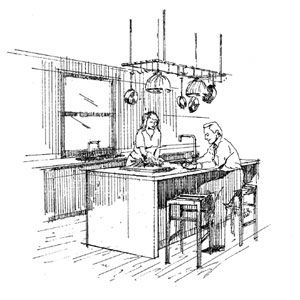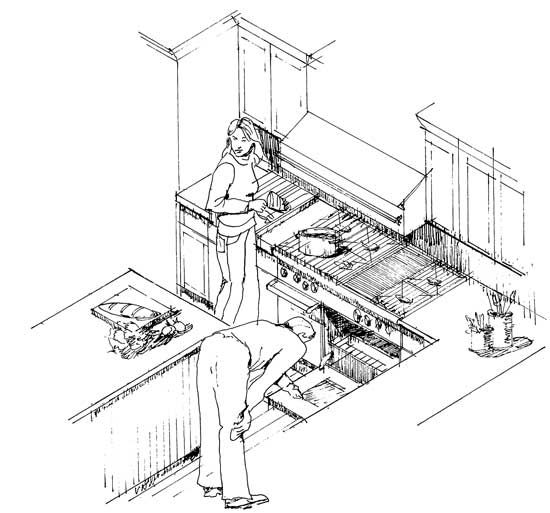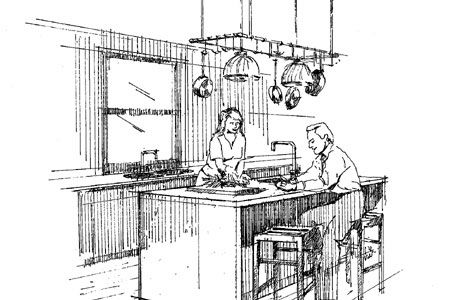
Q:
We’re a couple who both like to cook. How do we design a kitchen we can work in together without tripping over each other?
A: William Green, principal of William Green & Associates, a six-person design firm in New York City specializing in environmentally responsible architecture, anwers:
It would vastly simplify matters, of course, if one of you preferred the dinner shift and the other handled breakfast. But short of turning your living room into a second kitchen or flipping a coin to decide who gets privileges on a given day, there are some specific strategies you can consider to make a two-cook kitchen work. Here are the design guidelines I follow when preparing meals is a joint effort.
1. Counter Space
As a rule, the more counter space each of you has, the better. You don’t want to be knocking elbows as you work. One way to avoid clashing, even in a tight space, is to designate different areas of the counter for different functions. Allocating a healthy portion as butcher block, for example, provides a dedicated prep area for slicing and dicing and leaves the remaining surfaces available for other cooking activities. Island and peninsulas are also wonderful work surfaces, which when made sufficiently deep (36 inches is optimal) allow you to “double-load” the counter so that two people can work across from each other at the same time. In addition to its cooking benefits, this also gives you the opportunity to gaze into each other’s eyes and to easily pinch a taste of what the other is making.
2. Adequate Separation
Provide ample space on either side of each appliance, so that the two of you can work unimpeded and keep the cooking utensils and ingredients you need at the ready. It’s also helpful to separate the cooking and preparation areas. When you’re tossing that salad, you don’t want to be in the way of someone taking a casserole out of a 400-degree oven.
I like to design kitchens with an additional prep station within the pantry area, complete with a sink if space allows. This kind of “bonus” area is a convenient staging spot for putting away groceries or assembling ingredients. Similarly, a butler’s pantry between the kitchen and dining room is an excellent transitional area, where you can put the finishing touches on a dish before it’s served. Include a sink, and you now have a place to stack dishes between courses, keeping your primary sink clear for cookware.

3. Passage Width and Appliance Placement
When looking to maximize cabinet and counter space, many homeowners make the mistake of skimping on the width of the passage between rows of cabinets or between the cabinets and an island. Bumping and grinding is fine for dancing, but not when you’re carrying a plate of hors d’oeuvres or a pot of boiling water. A 48-inch passage is an ideal clearance between counters, as it allows two people to comfortably move in front of or behind each other.
Try to place your appliances at the end of the corridor or facing an open area. Avoid putting them in a corner or at the end of a counter—both chefs should be able to access the appliance at the same time. Whenever possible, don’t have an appliance directly facing a row of cabinets:?An open dishwasher, oven, or refrigerator door presents a roadblock. If space and budget permit, choose cooktops with at least six burners. A 48-inch-wide cooktop will easily accommodate two people working. Ditto for double wall ovens. Not only are they easier to access, but neither chef will have to reserve oven time in order to complete the meal.
4. Water, Water Everywhere
I like to include an additional service sink within the kitchen proper. With a secondary water source, there’s no need to fight over the faucet. Also, choose sinks that have integrated colanders or cutting boards that fit into the basin. These features are an indispensable way to provide alternative locations for food preparation and, most important, maintain domestic harmony within the kitchen.
